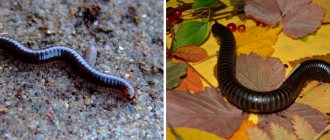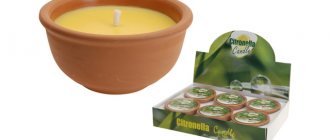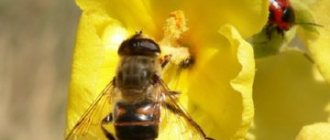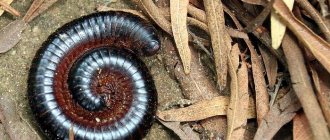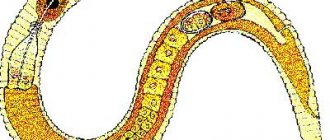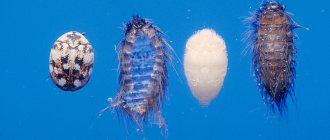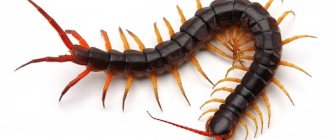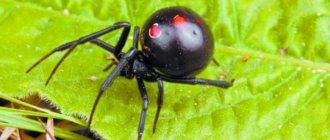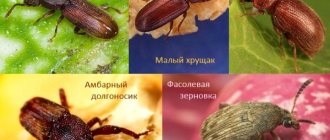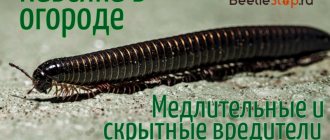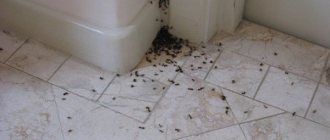Gardeners can often see worm-like pests eating strawberries. In fact, these are not worms, not wireworms and not caterpillars, but moths. This is the common name for millipedes, which have two pairs of legs on each body segment (except for the four front and rear). Who are these noobs and how to get them away from strawberries, let's figure it out.
- Kivsyak: description of the pest
- Signs of plant damage and damage
- Risk group
- How to deal with worms on strawberries
- Using traps against nooses
- Measures to actively combat kiwis
Kivsyak: description of the pest
Kivsyaki are distributed almost everywhere. Their body length varies from 3 mm to 28 cm (in tropical species). They live in the soil, adhering to layers with a moderate level of moisture. Almost all of them feed on diseased, damaged, dead or rotting parts of plants in the upper layers of the soil, as well as fallen fruits and berries lying on the ground. But with a severe lack of moisture in the soil or mass reproduction (every 3-4 years), they can feed on green, succulent plant tissues and cause serious damage, since they can eat 1.5 times their weight in a day. When disturbed, they first curl up into a spiral, shaped like a snail shell. If you continue to disturb them, they begin to sharply bend the ends of their bodies in opposite directions, “convulsing.”
Nooks, or centipedes
In our country, strawberries (garden strawberries) are most often damaged by the spotted or speckled grasshopper (Blaniulus guttulatus). Depending on the phase of development and age of an adult nod, the color of its body varies: light brown, spotted, even black. The nodule is speckled towards the end of its life, but it lives for several years, reaching 5 cm in length or even more. It is active in the dark, hiding in shelters during the day, but on cloudy days, in shaded places and in wet weather it comes to the surface during the day.
Reproduction occurs at a temperature of +22...+28 °C and 85% humidity. In the soil, from a mixture of soil and excrement, the female builds a dome-shaped nest, where she lays up to 70 eggs. Sometimes eggs are laid in clusters in the ground, under stones and other objects on the soil surface. After 2 - 4 weeks, larvae emerge from them - smaller copies of adult nooses. Their full development can take up to 3 years. The larvae molt periodically; after each molt, their body increases by one segment. In dry weather, the nodule crawls under stones, tiles, boards, heaps of garbage, tops, creeping grass and other objects under which moisture remains longer than in an open area. When the top layer of soil dries out, they go into the ground. Both larvae and adults overwinter in the soil.
Factors contributing to the appearance of centipedes in the garden
By and large, no area is immune from the appearance of centipedes. Let's consider the main factors contributing to the appearance of centipedes on the site:
- wet and flooded places;
- errors and malfunctions of the water tap, pipes, sewerage;
- an abundance of rotting parts of plants and fruits;
- fallen leaves;
- accumulation of wet wood waste;
Millipedes crawl into open areas to get food. They reproduce in humid conditions and in the absence of a direct light source. Millipedes by nature belong to the group of herbivorous insects, but some species feed on smaller insects. Herbivorous centipedes cause irreparable damage to agriculture, as they feed not only on the remains of decaying plant food and wood, but also on plant crops.
In the table we consider what vegetation centipedes prefer to the greatest and least degree:
| Commonly affected plant crops | Plants that are less affected |
| Strawberry | Tomatoes |
| Strawberries | Beans |
| Potato | Melons |
| Carrot | Tubers of flowers |
| Beet | cucumbers |
| Cabbage leaves | Wheat roots |
| Turnip | Radish |
Millipedes destroy young plants and crops, which causes enormous harm to garden crops. Many species of centipedes destroy harmful insects and act as orderlies. You can meet them when loosening, digging the soil, forming holes and beds. They live in moist soil in beds in open and closed ground. They are localized in places near sewage drains, water taps, and artificial reservoirs.
Signs of plant damage and damage
Signs of damage are not specific. Kivsyaki gnaw holes of varying depths in the berries. But often inside the hole you can find a larva of a noose or even several larvae intertwined in a ball. Damaged berries acquire an unpleasant odor and cannot be used for food. In a cold and wet spring, nodule moths can damage the root system and underground part of the stems of many crops, gnawing out small cavities in them. The affected areas turn brown or black. Plant development slows down, and if severely damaged, they dry out and die. In cases where woodlice and woodlice are present in the soil together with woodlice, the damage to cultivated plants is most serious.
Kivsyak in strawberries
How do centipedes hunt and feed?
Although the centipede insect is a predator, in the absence of usual food for a long time, it can also eat plants, for example, some types of domestic flowers. But the basis of their diet is:
- Worms.
- Flies.
- Cockroaches.
- Larvae.
- Fleas.
- Butterflies.
- Bedbugs.
Centipedes prefer to hunt in the dark. Sitting in a secluded place, these insects lie in wait for potential prey, using special antennae that are able to detect the slightest movements, smells and sounds. Seeing the presence of a beetle or cockroach suitable for food, the centipede quickly jumps on its prey, and then, holding it with the help of its jaw processes, injects poison into the body of the prey, which kills it instantly. After this, the flycatcher eats its lunch and goes to a secluded place for a while to calmly digest the food.
Risk group
The Kivsyak diet includes root vegetables: carrots, potatoes, radishes, turnips, radishes, beets. As well as apples (carrion), overripe melons, tomatoes and strawberries or raspberries touching the soil. Germinating seeds of cucumbers, tomatoes, zucchini, melons, peas, corn, beans, stems and roots of any seedlings. Chickweeds also eat cucumbers lying on the ground, leaves of cabbage, lettuce, champignons (and other mushrooms), as well as decorative potted crops in closed ground.
Reasons for appearance and habitat in the apartment
So, we know: for woodlice to appear in an apartment, there must be high humidity (dampness), which will be an ideal factor for the existence and reproduction of small creatures. Perhaps in nature these representatives of the fauna feel more comfortable than in a space limited by walls, but once in human housing, they choose:
- Bathroom or toilet room.
- Storerooms.
- The kitchen, especially the areas under the sink.
- Ventilation shafts and air ducts.
What attracts woodlice there? Now let’s figure it out, because the reasons can be very different:
- In the kitchen there are leftovers of food that have already begun to rot in the trash can.
- Stagnant water in buckets, bowls or other containers.
- Leaking toilet and wet rags on the floor.
- Wet laundry that has been left in the bathroom for too long.
- Excessive watering of indoor flowers leads to stagnation of water and the appearance of a musty smell.
- Vegetables and fruits stored in a closet or on the balcony.
- Dirty dark corners of rooms.
- Damp walls, ceilings or floors.
- Old, compacted books, etc.
How to deal with worms on strawberries
- Deep plowing in the morning frost in late autumn (nose grasses are heat-loving and die at low temperatures).
- Destruction of weeds and timely removal of plant residues.
- Putting things in order: there should be no scraps of boards, slabs, pieces of slate, etc. lying unattended on the ground.
- Loosening the soil to reduce the moisture content of the surface layer.
- In spring, you can isolate young strawberry leaves from the soil surface with a layer of straw or shavings (mulch). You can also isolate the berries using supports for the flower stalks.
- Manual collection of adult nooses and their larvae late in the evening, early in the morning and on cloudy days.
- Before the strawberries ripen, you should start using pieces of potatoes or carrots as bait, spread throughout the area with timely periodic collection and destruction of the nooses.
- During the ripening period, the soil under the strawberry bushes should not be over-moistened.
- When detected, affected berries must be removed immediately.
- It is important to harvest the berries promptly and completely.
Attention! When touched, moths often secrete a pungent secretion, which has a specific odor and colors the hands red or brownish-purple. Sometimes this secretion causes an allergic reaction, so it is recommended to use gloves.
Noiseweeds and other worms are found quite often on strawberries.
Prevention
It is easier to prevent kiwis from entering the garden than to get rid of them later. Therefore, you need to follow these site processing rules:
Liming the soil to a depth of 20 cm will help clean the soil from the pest.- After harvesting the autumn harvest, plant residues, especially weeds, are removed from the soil before planting crops.
- Late autumn plowing and earlier spring cultivation raises heat-loving pests - they die from the cold.
- From time to time it is useful to sow green manures - green fertilizers - on the site. In this capacity, you can use white mustard, yellow lupine, peas, and sunflower.
- Mulching and agrofilm will protect ground crops from pests.
- Organic fertilizer (manure, humus) must be carefully inspected before applying to the soil, since the pest can enter the site in this way.
Lime consumption rates for liming (kg/sq. m):
| Acidity, pH | Clay, loam | Sands, sandy loam |
| Less than 4.0 | From 0.5 | 0,35 |
| 4,1…4,5 | 0,4–0,5 | 0,25–0,3 |
| 4,6…5,0 | 0,3–0,4 | 0,2–0,4 |
| 5,1…5,5 | 0,3…0,25 | They don't contribute |
| 5.5 and above | They don't contribute | They don't contribute |
Before liming the soil, it is necessary to clarify the conditions for growing the crop. If you need acidic soil, then it is better to avoid liming, since the pH increases after such treatment. Such crops include, in particular, rhododendron, blueberries, azaleas, and potatoes. Also, you cannot add lime at the same time as digging up green manure.
All construction waste must be removed from the garden - boards, slate, bricks. Invertebrates usually live in these mini-dumps.
The fruits of strawberries and cucumbers will not be damaged if you tie up the vines and install supports. Water the soil moderately and do not over-moisten it. The harvest is harvested in a timely manner, without allowing the fruits to fall off.
As already mentioned, grasshoppers start in manure heaps and compost pits. To prevent the pest from entering the garden, the fertilizer must be prepared correctly. So, the manure pile needs to be watered and mixed. Then a temperature of 60°C or higher is created inside, causing the centipede to die.
When preparing composts, the components - food waste, peat, sawdust, etc. - are stacked in layers, each sprinkled with superphosphate, potassium chloride or watered with a solution of table salt (take 1 liter of salt per bucket of water).
Owners of summer cottages noticed that centipedes crawl out of the ground in the rain, like worms. After a rainstorm, they can be collected by hand and destroyed.
Using traps against nooses
Construction of artificial shelters from available materials: pieces of boards or old roofing felt, wet rags, etc. under which nods gather, followed by inspection of shelters and destruction of pests under them. You can also use food bait - spread pieces of carrots, potatoes, apples around the area, followed by collecting and destroying the noose. You can dig trapping grooves up to 10 cm deep and 6–7 cm wide, at the bottom of which mayonnaise jars are dug at a distance of 2–3 m. When crawling along the surface, the nooses fall into the groove, crawl along the bottom and end up in the jars. In the fall, you can dig holes 30 x 30 cm in size and 30 - 40 cm deep, put leaves, slices of potatoes, carrots and vegetable waste in them, sprinkle with a 5 - 10 cm layer of earth. Mark the holes with branches so that they can be easily found. With the onset of frost, take out the contents of the pits and burn them together with the nodules on a fire, or simply scatter them around the area - all the pests gathered for the winter will die. Repelling squids with superphosphate, ash, soap-kerosene emulsion, as well as using molluscicides (Thunderstorm, Slug Eater) against them is ineffective, since the surface of the squid's body is protected by a thick layer of chitin. These products can cause minor harm only to recently molted larvae, whose chitinous layer has not yet reached the required size.
Strawberry (garden strawberry) spoiled by kiwi
Modern means
Many modern people also know how to get rid of centipedes in the house. To do this, they use toxic drugs that destroy not only the flytrap, but also other uninvited guests that it attracts. Since such products belong to the category of strong chemicals, it is necessary to take safety measures. During processing, you should wear a mask and gloves, and after finishing work, ventilate the room.
The following drugs are suitable to combat flycatchers:
- "Dichlorvos Neo". Available in aerosol form, which is odorless. It kills centipedes almost instantly. The effect of the drug lasts for two weeks.
- "Raid". Also presented in the form of a spray, but with the scent of lavender. Continues to work for several days after treating the room. The product must be ventilated.
- "Medilis-Ziper". This is a rather toxic product that needs to be sprayed on the intended habitat of centipedes. The drug stands out from the rest because it does not harm pets.
View gallery
- "Clean house". This product is more suitable for destroying centipede nests. But it also effectively copes with other pests.
- "Global". It is a toxic paste for killing various pests. It must be applied to arthropod habitats and around the perimeter of the room. The smell of the paste is unpleasant, but weak.
Measures to actively combat kiwis
At the moment, the list of pesticides and agrochemicals approved for use in the Russian Federation does not contain recommended preparations for protecting plants from grasshoppers. This is explained by the fact that the areas are treated with pesticides during daylight hours, when a significant part of the nooses are located in shelters and are not treated. Even the application of preparations aimed at destroying root pests of plants (wireworms, mole crickets) does not give a noticeable result in the fight against noose. You can use the drug Nemabakt - it works against soil-dwelling harmful insects, and even though nouns are not insects, there is a chance that nematodes will also be able to handle their larvae. You can find out more about Nemabact here >>>>>.
Ghana gharial
The Ghanaian gharial is a reptile of the order of crocodiles, but despite its impressive size and the presence of a huge number of teeth, it does not pose a danger to humans. Gharials are rare ancient animals on the verge of extinction that live in the north of the Hindustan Peninsula. They live in calm areas of deep rivers and very rarely go onto land. Over centuries of close cooperation with gharials, people have become convinced that this scary-looking animal does not pose a threat to humans. The only trouble is that there is an opinion among fishermen that gharials are responsible for the decline in fish populations, but at the same time in India they are still considered sacred animals and they do everything to preserve the population of these unusual reptiles.
Precautionary measures
Despite the fact that these animals very rarely attack first and try to quickly crawl away from potential danger, precautions must be taken. After all, at the dacha you can meet not only harmless snakes, but also vipers, whose bite is very dangerous
Rules that will keep you safe:
- Wear shoes at the dacha.
- When working in the garden beds, wear gloves and protect your body with thick clothing.
- Mow your grass regularly.
- Remove fallen dry leaves from the ground.
- Inspect the vegetation carefully.
What to do when meeting
If you unexpectedly encounter a reptile, there is no need to panic and make sudden movements. Treat it the same way you would treat a strange dog.
- Gently start moving back and let the animal crawl.
- Don't turn your back on her, don't twitch or run away. Some species of these reptiles have very poor vision, but have good hearing. Therefore, there is a high probability that when the snake hears you moving away, it will crawl away.
- Do not try to catch the reptile or kick it away.
- Call the trapping service.
Nutrition
Kivsyaks are often called gluttons, because in one month they consume a bucket of food. Their diet consists of mushrooms, rotten shoots, bark, and so on. However, when caring for a centipede in an apartment, you don’t have to worry about its diet, because it is omnivorous. Eats both meat products and dairy products (cottage cheese). Some people feed their pets fruits, vegetables and any other plant foods.
A notable fact about diplopods is that they often eat chalk. This is due to the content of calcium and vitamins in the composition (they strengthen the shell). Chalk can be replaced with egg shells. You should not give too much food, otherwise mold will begin to form on the leftover food. Therefore, they should be removed immediately.
A favorite place for breeding is considered to be a manure heap, which is why many summer residents often find these invertebrates in the ground. If you do not take any measures to combat them, they will soon begin to gnaw on the roots, as a result of which the plants will simply stop growing normally due to lack of nutrients. It is not always possible to see such small pests, because their length is a maximum of one and a half centimeters.
As mentioned earlier, the color of the shell of centipedes depends on their variety. They are black, white, olive, yellow, brown. Their bodies have a large number of warts and sparse setae; each segment contains two pairs of legs.
Quite often, nodules end up on tubers along with manure. That is why, before buying any fertilizer, it is recommended to carefully inspect it and check for the presence of these small pests and their larvae.
To prevent unexpected “guests” from appearing on your site, the gardener should periodically clean the soil and greenhouse (remove plant debris), and also treat the soil annually using chemical and thermal methods.
Which method to choose
When infecting strawberry bushes with a nematode, you should remember that even the use of strong chemicals does not provide complete confidence in the destruction of the parasite. In addition, especially novice gardeners should not get carried away with chemistry and it is better to try not to use it or only in extreme and critical cases of infection. Experienced gardeners have much more experience using such methods. It would be preferable for both to use numerous folk remedies and carry out prevention.
By using control methods and watering correctly, as well as fertilizing strawberries in a timely manner, it is possible to completely prevent the pest invasion. But still, if this fails, the necessary measures are urgently applied, then the strawberry harvest will be preserved.
Home maintenance
The largest member of the family, the African giant nodule, is most often chosen as an exotic pet. Maintaining a kivsyak will not cause much trouble:
- The first step is to choose a suitable terrarium. It doesn't have to be deep because centipedes don't climb walls. The container must have a large area so that the nodule can run along the bottom.
- At the bottom you need to put a bedding 7-10 cm thick. Suitable:
- ready-made coconut substrate;
- leaves;
- wood chips;
- wood that has begun to rot.
- Humidity in the terrarium should be between 70-90%, temperature 30 ° C during the day, and 5-7 ° lower at night.
- Diet of “homemade” nodule:
- stale, rotten plant products (leaves, fruits, vegetables);
- mushrooms;
- rotten wood.
- Calcium is definitely needed as a mineral supplement:
- lime;
- chalk;
- crushed eggshells;
- dolomite flour.
- Once a month, you can give cat food as a vitamin supplement.
Note! Nosetails reproduce well in captivity; they do not need to create any additional conditions for this. They lay eggs directly in the soil of the terrarium, so you should not change the litter while waiting for the “addition”.
Five tricks to help protect your harvest from damage
Every summer resident knows that fresh, just picked strawberries are more fragrant and sweeter than imported ones, potatoes are more crumbly, and carrots are healthier. To the surprise of city gardeners, many earth dwellers - unexpected co-owners of the site - have full control over the harvest. Particular irritation is caused by a variety of crawling creatures, which include centipedes - giant nodule.
The desire to get rid of diploids is understandable, but not always rational. The crop is damaged more often by others - the organisms accompanying the crops, which end up in the garden with natural organic fertilizers.
Agricultural standards superficially describe the technology for combating centipedes, while textbooks pay more attention to the destruction of other pests
Harmful worms usually prefer other food - damp and rotten leaves. But, once in beds cleared of such debris, they can compete with humans in the consumption of garden crops, destroying tubers, individual roots and low-hanging fruits. The greatest troubles can be caused to lovers of home flowers, as well as to owners of greenhouses, conservatories and hotbeds.
Preventive actions
In order for the worm to stop spreading on strawberries, first of all, you need to take care of high-quality planting material. When inspecting seedlings during purchase, pay attention to the roots. They should be without the slightest sign of damage, but even in this case, they must be treated with hot water before planting.
During the entire growing season, the soil requires composting. Compost contains fungi that destroy the nematode pest.
An important aspect is constant compliance with crop rotation. For strawberries, it is necessary to change the growing location every 5 years. This measure minimizes the spread of the nematode throughout the area.
Important information! It will not be very good to plant cabbage, peas, beans, carrots and potatoes next to strawberries.
When nematode treatment has been carried out, for the next season you can choose berry varieties that are more resistant to the parasite. These can be varieties:
In the spring and autumn, it is necessary to carefully remove the remains of plants and unnecessary grass from the garden. All this is necessarily burned, and those pests that remained there, preparing to spend the winter, are destroyed.
When planting, it is necessary to avoid thickening of plants. They are periodically thinned and weeded. This reduces the number of nematodes significantly.
What to do?
So, when woodlice appear in an apartment, the question arises of how to get rid of them. Although the reproduction of these creatures in huge numbers is a rare occurrence, meeting even one or two individuals leads to an immediate decision to evict them as quickly as possible. Where to start the fight? The first thing that usually comes to mind is to find the location of the small monsters and destroy them. This is correct, but we must also make sure that they give up hope of returning to their homes. Consequently, serious work will have to be carried out on extermination, and then, in order to avoid the return of the hated creatures, and on prevention.
Cleaning and drainage measures
Since woodlice are most often attracted to dark, damp corners, it is necessary to clean, throw out trash, remove from under the bathtub everything that can serve as their home and food. Fighting dampness is an important step in driving out unpleasant neighbors. It may be necessary to carry out global drainage measures, minor plumbing work (for example, check the condition of pipes, eliminate leaks in their connections) or connect household appliances (fans, air conditioners).
It is worth checking, repairing or adjusting the ventilation system in the bathroom. To remove woodlice, you can also think about installing forced ventilation. Replacing metal pipes with plastic ones will help reduce the formation of condensation. It is necessary to seal the cracks in all places where small monsters may appear. They do not live in a dry room, so they often win the war against woodlice at the first stage.
Enticement into compost pits
The technique of using bait traps has been developed, which is as follows. They dig holes like compost pits. Ensure they are attractive to invertebrates by filling them with all organic garden waste.
The efficiency of catching and killing centipedes increases when the contents are treated layer by layer with chloride salts (sodium or potassium).
If the mixture is regularly moistened, mixed and covered with turf in the summer, a climate unfavorable for protein life will be created inside. In late autumn, compost is scattered over the surface of the soil for the purpose of freezing.
The odoriferous wood borer is also called the willow borer because willows are its favorite food. A complete description of the insect can be found here.
To combat potato moth, you can use both chemical treatment and traditional methods. You will find detailed information at this https://stopvreditel.ru/rastenij/selxoz/kartofelnaya-mol.html link.
General principles of snake removal
Since all snakes are predators, they are capable of destroying any living creature of the appropriate size around them. Their primary food source is mice, small birds and frogs.
Having settled in some area, snakes immediately begin active work to destroy all this living creature. In the ecosystems of gardens and vegetable gardens, each representative of the same birds is practically priceless, so their extermination must not be allowed.
Snake
In addition, snakes can also attack chickens while they do not yet have the strength to resist them. We should not forget about the danger of reptiles for humans - even in our not at all warm regions, there are several species of poisonous snakes that pose a danger to humans.
In general, due to a combination of factors, proximity to snakes is extremely undesirable for any gardener or gardener. And this neighborhood must be stopped immediately.
It is necessary to fight snakes in your garden plots and prevent these reptiles from entering the human habitat.
Reptiles are quite primitive creatures. Most of them lack even basic reflex functions. However, their set of instincts is quite enough to exist for more than 300 million years.
The behavior of snakes is quite predictable.
If snakes appear on the site, there can only be two reasons:
- here are acceptable living conditions for them, that is, their home may be located here - a snake’s lair
- there is a food supply on the site - small rodents (mice, hamsters) or amphibians (frogs and toads)
Snake in the process of feeding
There are no other reasons for the appearance of snakes. These animals lead a sedentary lifestyle and almost never migrate. They can look for new places to live only if their previous home was destroyed or captured by competing animals.
Thus, in order to discourage snakes from your area, you need to fight not the effect, but the cause: either make the living conditions for snakes unacceptable, or deprive the reptiles of their food supply.
But these are strategic issues, one might say global.
Their decision is very important, but it has a more or less long-term perspective. And there is another one - short-term: what to do in the case when the snakes are already here and stubbornly do not want to leave? The article will discuss the solution to these issues in more detail.
The article will discuss the solution to these issues in more detail.
What harm does it do?
Various types of stem nematode worms live in the ground and can eat strawberries; they pose an even greater threat when there are a lot of them around the plants. Females are capable of producing a huge number of offspring at one time. Here's what damage a worm can do to strawberries:
- Worms in strawberries suck the juice from the leaves and stems;
- They introduce a substance similar to a chemical into plants to soften the stems and leaves;
- The berry becomes wormy and tasteless;
- Strawberries damaged in this way become less resistant to various types of infections.
Important information! The pest is a distributor of fungus and other viruses.
Worms in strawberries can be dangerous to humans, especially to children, as the pest contributes to the occurrence of certain diseases. If these parasites have infected the human body, the following symptoms may be observed:
- Allergy appears on the skin;
- Decreased appetite may occur, as well as nausea accompanied by vomiting;
- Muscle pain;
- After intoxication, a feeling of general weakness is detected;
- In rare cases, there are deviations in mental state and depression.
Nematode on strawberry
